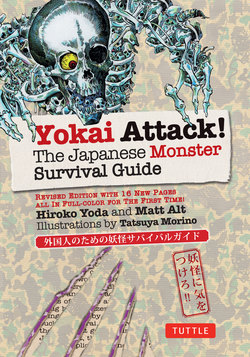Читать книгу Yokai Attack! - Hiroko Yoda - Страница 28
На сайте Литреса книга снята с продажи.
ОглавлениеFerocious Fiends: 009
Umi-bozu
海坊主
Pronunciation:
(OO-mee BOH-zoo)
English Name:
Literally, “Sea Monks”; Pelagic Phantoms
Gender:
Unknown
Height:
From 4 in. (10cm) to over 100 ft. (30m)
Weight:
Equivalent to equal mass of seawater
Locomotion:
Wave motion
Distinctive Features:
Domed, jellyfish-like body
Smooth, pitch-black skin
Glowing eyes
Offensive Weapons:
Water
Weaknesses:
None known
Abundance:
Prevalent
Habitat:
Open seas
Claim to Fame:
In spite of the cute-sounding name, the Umi-bozu have long struck terror into the hearts of Japanese mariners. Some say they are the vengeful spirits of drowned sailors; others say they are strange mutations of deep-sea life taking monstrous supernatural form. Whatever the case, the Umi-bozu look nothing like any creature from this world, taking the form of jet-black, dome- or drop-like beings with glowing eyes. It has been suggested that they may actually be composed entirely of water, which would explain the near-total absence of any other distinguishing features. Although many seem to lack mouths, they are often described as issuing an unsettling sighing or moaning sound.
Umi-bozu come in a variety of sizes; the smallest, roughly four inches, are occasionally caught in fishing nets. Perhaps these are the juveniles of the species. Medium-sized Umi-bozu are large enough to menace fishing boats; at their largest and most fearsome, they tower over the surface of the water.
This 1970s Robo-Umi-Bozu model kit is an interesting variation.
The Attack!
Unlike the Funa-yurei, (p. 46), which only appear at night and in coastal waters, the Umi-bozu appears far out to sea and shows itself at any time of the day. It sometimes accompanies (or is accompanied by) strange atmospheric or oceanic phenomena such as storms. Umi-bozu rise from the surface of the ocean; fed by its limitless waters, it is capable of growing in size until it looms over even the largest of ships. It prefers brute-force attacks, attempting to engulf individuals, ships, or even entire fleets, depending on their size.
A woodblock print by Utagawa Kuniyoshi depicting an Umi-bozu
Surviving an Encounter:
This probably goes without saying, but avoid putting out to sea when strange weather is on the horizon. Smaller Umi-bozu respond with cries of pain when hit with poles or oars, meaning it is theoretically possible to injure them. It may be possible to fend off small or medium Umi-bozu with whatever tools are at hand, but a full-sized specimen is another story. If you see one on the horizon, finding a safe harbor is your only hope for survival.
Don’t let your guard down once you’ve reached shallower waters, however, particularly if darkness is falling. If conditions are right for the Umi-bozu far at sea, chances are you may well encounter Funa-yurei on the way back.
Marine Monster Mating?
According to Kanso Jigo (“Speculations on Natural Tales”), an eighteenth-century text composed by historian Norimitsu Yanagihara, smaller and medium-sized Umi-bozu very occasionally appear close to shore. Residents of the town of Izumi in Osaka reported that one remained in some nearby shallows for three days before returning to sea. During these times the townspeople took pains to avoid the coastline, but those who caught glimpses said that the Umi-bozu took on an almost humanoid appearance. Yanagihara did not propose any sort of explanation for this behavior, but we speculate that it may be a form of mating ritual for the creatures.
Country Cousins:
Although most commonly referred to as Umi-bozu, this yokai is given a variety of names throughout Japan. Fishermen on the island of Sado, located off the west coast of Japan, speak of the Tate-Eboshi, a sixty-five-foot (twenty-meter) tall creature that attempts to swamp any boat it encounters. Meanwhile, fishermen in Shiriyazaki, at the northeastern tip of Japan’s main island of Honshu, have a tradition of mixing miso paste with water and pouring it into the sea to drive away the Mojabune, another towering yokai of the high seas.
BEARDED BOZU
Some accounts describe the skin of the Umi-bozu as being covered in ultrafine hair. The veracity of these claims remains unknown. If true, an Umi-bozu’s “pelt” is probably similar to that of other marine mammals such as the sea otter, the dense fur of which contains some one million hairs per square inch of skin! (By comparison, an average human has only one hundred thousand hairs on their entire head.)
